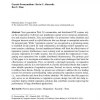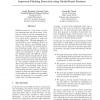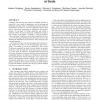47 search results - page 9 / 10 » Identity Theft, Social Security Numbers, and the Web |
ECR
2010
13 years 8 months ago
2010
Next generation Web 2.0 communities and distributed P2P systems rely on the cooperation of diverse user populations spread across numerous administrative and security domains. Zero...
CEAS
2008
Springer
13 years 10 months ago
2008
Springer
Phishing emails are a real threat to internet communication and web economy. Criminals are trying to convince unsuspecting online users to reveal passwords, account numbers, socia...
PET
2010
Springer
14 years 15 days ago
2010
Springer
Combining and analyzing data collected at multiple locations is critical for a wide variety of applications, such as detecting and diagnosing malicious attacks or computing an acc...
ICISC
2007
13 years 10 months ago
2007
In Ubiquitous Computing Environment (UCE), service provider wants to provide its service to only legitimate users. Some users who belong to same service provider do not want to rev...
ACSAC
2010
IEEE
13 years 6 months ago
2010
IEEE
Twitter is a new web application playing dual roles of online social networking and micro-blogging. Users communicate with each other by publishing text-based posts. The popularit...



